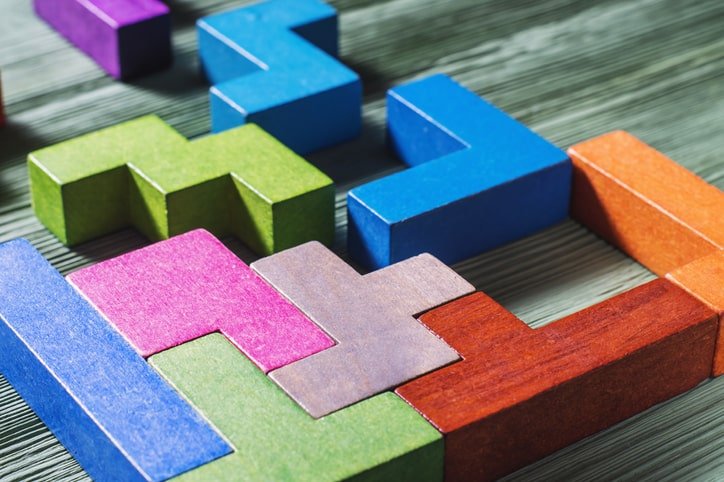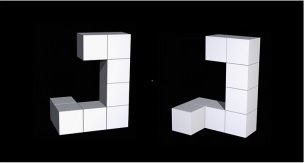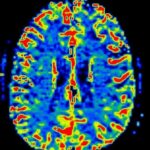Spatial intelligence is crucial for many tasks, yet it’s often neglected at school. Can we improve visuo-spatial ability? Experiments indicate that we can. Here’s what you need to know.

Spatial intelligence: A definition and some examples
Spatial intelligence, or visuo-spatial ability, has been defined “the ability to generate, retain, retrieve, and transform well-structured visual images” (Lohman 1996).
It’s what we do when we visualize shapes in our “mind’s eye.”
It’s the mental feat that architects and engineers perform when they design buildings. The capacity that permits a chemist to contemplate the three-dimensional structure of a molecule, or a surgeon to navigate the human body.
It’s what Michelangelo used when he visualized a future sculpture trapped inside a lump of stone.
It’s also the mode of thought we use to imagine different visual perspectives. Are these two shapes different? Or are they identical and merely oriented differently?

This is a classic mental rotation test – one what that researchers measure visuospatial ability (Anomal et al 2020). Another spatial intelligence test presents a figure made of blocks, and asks the test taker to create an exact copy.
Such skills are only one aspect of a person’s overall intelligence. But research suggests that spatial thinking is an important predictor of achievement in STEM, or science, technology, engineering and mathematics.
For example:
- Preschoolers who are better at visualizing spatial relationships develop stronger arithmetic abilities in primary school (Zhang et al 2014; Gilligan et al 2017; Verdine et al 2014; Verdine et al 2017).
- Middle school students who are good at mental rotation are more likely to achieve in science classes (Ganley et al 2014).
- Wai et al 2009; Uttal et al 2013).
Teens with excellent spatial skills are also more likely to secure employment in the visual arts or business (Wai et al 2009).
And there is even evidence that early spatial ability predicts a young child’s reading skills (Franceschini et al 2012).
So clearly spatial skills matter. Is there anything we can do to boost visuo-spatial ability?
There’s a lot we can do, and if you can find a checklist of practical tips for enhancing spatial intelligence here.
But how do we know it’s possible? Let’s take a closer look at the science of spatial training.
Nature and nurture: How hormones and practice effect spatial performance
People often assume that spatial intelligence is a biologically-determined cognitive trait, a gift you either have or don’t. This attitude may stem, in part, from observed sex differences.
Numerous studies report that males possess superior mental rotation skills. There is also evidence that spatial ability is linked with the amount of testosterone a fetus encounters in the womb (Puts et al 2007; Pintzka et al 2015).
In a recent experiment on 42 women, researchers found they could temporarily boost mental rotation skills by giving volunteers a single, small dose of testosterone (Pintzka et al 2015).
But whether or not the sex difference in mental rotation is influenced by hormones, there is compelling evidence showing that people can enhance their spatial abilities with practice.
And the results can be dramatic (Feng et al 2008; Wright et al 2008; DeLisi et al 2002; Cherney et al 2014):
After a relatively brief training period (ranging from hours to a few weeks), people of both sexes sharpen their skills.
And the gender gap?
It narrows or disappears.
So this suggests that we can improve spatial thinking through effort and practice. What does this practice actually look like?
How to improve spatial intelligence
For an example of training that works, consider this study by Rebecca Wright and her colleagues (2008). The researchers recruited 38 young adults at Harvard – about 50% of whom were female — and tested the volunteers on two tasks:
- mental rotation, and
- a mental paper-folding task, in which participants had to mentally “fold up” a paper template and predict its appearance.
At baseline, there were sex differences. The women made more errors on the spatial rotation task. The men made more errors on the mental paper-folding task.
But after 21 days of daily training (practicing each type of task), everybody got better. And the error rates converged. Men and women were now equally good at both spatial tasks.
Similar results have been reported in other experiments where adults were randomly assigned to practice spatial skills by playing certain action video games.
One key study found that undergraduates improved visual attention and mental rotation skills after only 10 hours of playing a 3-D, first-person shooter action video game. Overall, women made the biggest gains, and they maintained them 5 months later (Feng et al 2008).
Researchers have also trained children to improve their spatial intelligence.
David Tzuriel and Gila Egozi (2010) tested the mental rotation abilities of 116 first graders (average age, 6.5 years), and randomly assigned about half of them to a training program designed to help kids observe, transform, and keep track of geometric shapes in their “mind’s eye.”
The remaining children were assigned to an alternative, non-spatial training program.
At the beginning of the study, boys outperformed girls. But after only 8 weekly sessions, the girls in the spatial skills training program had caught up. The gender difference was gone.
Another experimental study found that brief spatial training can boost a child’s performance in mathematics (Cheng and Mix 2013).
After a single, 20-minute session of practice with mental rotation puzzles, kids (ages 8-6) earned higher scores on a math test compared with control-group peers.
The trained students became particularly good at algebraic problems, like “2 + ? = 7.” Researchers speculate that spatial training made it easier for kids to visualize and rearrange these equations in a more familiar format ( e.g., “7 – 2 = ?”).
In addition, a growing body of research suggests kids can improve their spatial abilities by engaging in structured block play — the sort of play where children recreate physical structures by following a model or blueprint.
Enhancing spatial intelligence through structured block play
In one study, Sharlene Newman and her colleagues assigned 28 children (aged 8) to one of two training groups.

- Half the kids participated in five, 30-minute sessions of structured block play.
- The other children spent the same amount of time playing the word game, “Scrabble.”
Before and after training, the researchers scanned the children’s brains (using fMRI technology) while the kids solved mental rotation tasks. How did task performance and brain activity change after training?
Unlike children in the “Scrabble” control group, kids who’d participated in the structured block play sessions showed statistically significant improvements in reaction time and accuracy.
They also showed changes in brain activity between the first and second brain scans. Post-training, they showed more activity in brain regions linked with spatial processing and spatial working memory (Newman et al 2016).
So we have good evidence that practice boosts spatial skills, which may explain why construction play is linked with childhood spatial ability. But that’s not all. It appears that kids also benefit from conversation.
Boosting spatial skills in children through joint play and spatial talk
People often find it easier to think about a concept when they have a word for it. And of course kids often pay closer attention to something if we engage them in a discussion about it. So can we help kids by engaging them in meaningful conversations about spatial relationships?
Studies suggest we can.
First, there are clear links between spatial intelligence and spatial vocabulary. In one study, preschoolers who knew more spatial words (like between, above, below, and near) were better at reproducing spatial designs with blocks (Verdine et al 2014). This was true even after controlling for a child’s overall vocabulary, suggesting that specifically spatial terms help kids think in 3-D.
Second, there’s evidence that kids perform better on spatial tasks when we supply them with helpful words. For instance, consider this experiment by Jeffrey Loewenstein and Dedre Gentner:
A child sees two small bookcases — one white, one blue. Each bookcase has three shelves and three hiding places.
In full view of the child, an adult hides a special card (“the winner”) on a shelf of the white bookcase, and then explains where she put it in one of two ways:
- by pointing and saying “I put the winner right here,” or
- by using spatial language “I’m putting the winner on the middle shelf”
Next, the child closes his eyes while the adult hides another card in the blue bookcase. When he opens his eyes, he’s told to look for the second card “in the very same place” on the blue bookcase.
It’s a simple test of analogical mapping. But surprisingly, most 3-year-olds had trouble getting it right when the adult merely pointed and said “I put the winner here.”
By contrast, kids performed significantly better when they got the directions that included spatial language.
And what about long-term cognitive development? Shannon Pruden and her colleagues (2011) addressed this question by tracking 52 toddlers from the age of 14 months.
In a series of sessions, the researchers watched families at play, and measured the how many spatial words parents used with their children. They also recorded the number of spatial words that the kids spoke, words like circle, triangle, tall, empty, line, end, and little.
Then, when the children were 54 months old, the researchers gave them several nonverbal tests of spatial intelligence, including an early childhood equivalent of the spatial rotation task.
As it turned out, the kids who’d heard many spatial words, and used a lot of spatial language themselves, earned higher test scores.
The effect wasn’t huge, and the study didn’t control for genetics. Parents and children may share genes that make them both more likely to use spatial talk and to perform well on tests of spatial intelligence.
But the researchers did control for overall parental language input, so it wasn’t merely that kids especially talkative parents developed better spatial skills.
The type of talk mattered, which makes sense: A rich vocabulary of spatial terms might encourage kids to pay more attention to the spatial information they encounter. And this enhanced attention should help kids learn.
Does every child get this same environmental advantage? Clearly not.
For instance, in a second study conducted by Pruden and Susan Levine, the researchers documented a sex bias in the way that parents talked to their babies.
Boys heard more spatial talk than girls did, and this bias seemed to have a impact later on, when the kids were 3 to 4 years old.
To the degree that girls used less spatial vocabulary at this age, the effect was “fully mediated by parents’ earlier spatial language use” (Pruden and Levine 2017).
That might sound discouraging. Are we denying children the opportunity to grow because we’re under the influence of cultural biases — biases we might not even be aware of?
Perhaps. But the situation is far from hopeless. Research suggests we can change our ways with a conscious effort.
For example, experiments show that simply reminding parents of the importance of spatial language prompts them to produce more spatial language and guidance to their children (Boriello and Liben 2018).
So we’ve got good reason to think that we can help children develop better spatial skills by cultivating our conversational skills. Seize everyday opportunities to talk about spatial relationships. And remember:
The goal isn’t to get a child to learn as many spatial terms as possible, but rather to help kids develop a quality understanding of the way shapes can be moved, transformed, and fitted together.
Spatial intelligence activities
What other practical steps can we take to help kids develop spatial intelligence? A growing body of research suggests that children hone visuo-spatial ability through certain kinds of play.
Read more about the benefits of construction toys, and click here for evidence-based activities and games that foster spatial intelligence in children.
Looking for construction toys and books that foster spatial awareness? See the suggestions below and these recommendations. A portion of your purchase will help support this site.
References: Spatial intelligence
Anomal RF, Brandão DS, Porto SB, de Oliveira SS, de Souza RFL, Fiel JS, Gomes BD, Pires IAH, Pereira A Jr. 2020. The role of frontal and parietal cortex in the performance of gifted and average adolescents in a mental rotation task. PLoS One. 15(5):e0232660.
Borriello GA, Liben LS. 2018. Encouraging Maternal Guidance of Preschoolers’ Spatial Thinking During Block Play. Child Dev. 89(4):1209-1222
Casey BM, Andrews N, Schindler H, Kersh JE, Samper A and Copley J. 2008. The development of spatial skills through interventions involving block building activities. Cognition and Instruction (26): 269-309.
Cheng YL and Mix KS. 2013. Spatial training improves children’s mathematics ability. Journal of Cognition and Development 15(1). Published online: 04 Oct 2013 DOI:10.1080/15248372.2012.72518.
Cherney ID, Bersted K, Smetter J. 2014. Training spatial skills in men and women. Percept Mot Skills. 2014 Aug;119(1):82-99.
De Lisi R and Wolford JL. 2002. Improving children’s mental rotation accuracy with computer game playing. J Genet Psychol. 163(3):272-82.
Feng J, Spence I, Pratt J. 2008. Playing an action video game reduces gender differences in spatial cognition. Psychol Sci. 18(10):850-5.
Franceschini S, Gori S, Ruffino M, Pedrolli K, and Facoetti A. 2012. A causal link between visual spatial attention and reading acquisition. Curr Biol. 22(9):814-9.
Ganley CM, Vasilyeva M, Dulaney A. 2014. Spatial ability mediates the gender difference in middle school students’ science performance. Child Dev. 85(4):1419-32.
Gilligan KA, Flouri E, and Farran EK. 2017. The contribution of spatial ability to mathematics achievement in middle childhood. J Exp Child Psychol. 163:107-125.
Levine SC, ratliff KR, Huttenlocher J, and Cannon J. 2012. Early puzzle play: A predictor of preschoolers’ spatial transformation skill. Developmental Psychology (48): 530-542.
Loewenstein J and Gentner D. 2005. Relational language and the development of relational mapping. Cognitive Psychology 50: 315-363.
Lohman DF. 1996. Spatial ability and g. In: Dennis I, Tapsfield P, editors. Human abilities: Their nature and measurement. Erlbaum; Hillsdale, NJ. pp. 97–116.
Newcombe NS, Levine SC, and Mix KS3. 2015. Thinking about quantity: the intertwined development of spatial and numerical cognition. Wiley Interdiscip Rev Cogn Sci. 6(6):491-505.
Newman SD, Mitchell Hansen T, and Gutierrez A. 2016. An fMRI study of the impact of block building and board games on spatial ability. Frontiers in Psychology 7: 1278.
Pintzka CW, Evensmoen HR, Lehn H, and Håberg AK. 2015. Changes in spatial cognition and brain activity after a single dose of testosterone in healthy women. Behav Brain Res. 298(Pt B):78-90.
Pruden SM, Levine SC and Huttenlocher J. 2011. Children’s spatial thinking: Does talk about the spatial world matter? Developmental Science (14): 1417-1430.
Puts DA, Gaulin SJ, Breedlove SM, et al. 2007. Sex differences in spatial ability: evolution, hormones and the brain. In: Platek, S.M. (Ed.), Evolutionary Cognitive Neuroscience. MIT Press, Cambridge, Massachusetts, pp. 329–379.
Stericker A and LeVesconte S. 1982. Effect of brief training on sex-related differences in visual-spatial skill. J Pers Soc Psychol. 43(5):1018-29.
Terlecki MS and Newcombe NS. 2008. Durable and generalized effects of spatial experience on mental rotation: Gender differences in growth patterns. Applied Cognitive Psychology 22: 996-1013.
Tosto MG, Hanscombe KB, Haworth CM, Davis OS, Petrill SA, Dale PS, Malykh S, Plomin R, Kovas Y. 2014. Why do spatial abilities predict mathematical performance? Dev Sci. 17(3):462-70.
Tzuriel D and Egozi G. 2010. Gender Differences in Spatial Ability of Young Children: The Effects of Training and Processing Strategies. Child Development. 81 (5): 141.
Uttal DH, Meadow NG, Tipton E, Hand LL, Alden AR, Warren C, Newcombe NS. 2013. The malleability of spatial skills: a meta-analysis of training studies. Psychol Bull. 2013 Mar;139(2):352-402.
Verdine BN, Irwin CM, Golinkoff RM, and Hirsh-Pasek K. 2014. Contributions of executive function and spatial skills to preschool mathematics achievement. J Exp Child Psychol. 126:37-51.
Verdine BN, Golinkoff RM, Hirsh-Pasek K, Newcombe NS. 2017. I. Spatial skills, their development, and their links to mathematics. Monogr Soc Res Child Dev. 82(1):7-30.
Wai J, Lubinski D and Bendow CP. 2009. Spatial ability for STEM domains: aligning over 50 years of cumulative psychologicl knowledge solidifies its importance. Journal of Educational Psychology 101: 817-835.
Wright R, Thompson WL, Ganis G, Newcombe NS, and Kosslyn SM. 2008. Training generalized spatial skills. Psychon Bull Rev. 15(4):763-71.
Zhang X, Koponen T, Räsänen P, Aunola K, Lerkkanen MK, and Nurmi JE. 2014. Linguistic and spatial skills predict early arithmetic development via counting sequence knowledge. Child Dev. 85(3):1091-107.
Images for “Spatial intelligence in children”:
Image of colorful geometric blocks by istock / Radachynskyi
image of brain scan by istock / wenht
image of three dimensional shapes for testing mental rotation from paper by Anomal et al 2020, available under creative commons license CCBY4.0
Written content of “Spatial intelligence in children” last modified 8/12/2018.